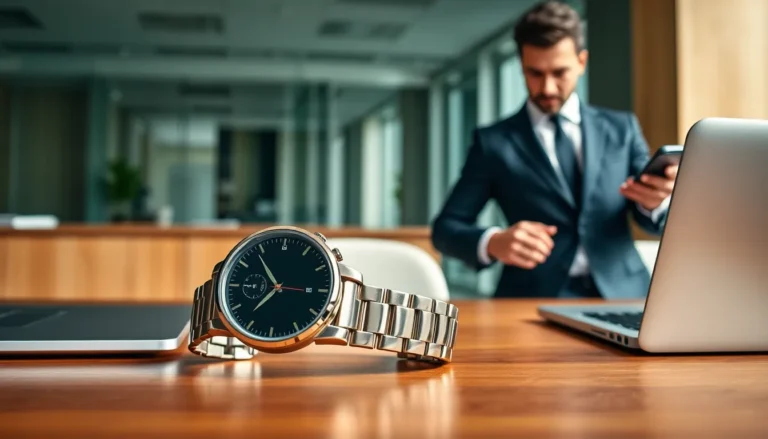Ever wondered if your iPhone’s packing some sci-fi tech? If you’ve been hearing whispers about LiDAR and its magical ability to measure distances and create 3D maps, you’re not alone. It sounds like something out of a space movie, but it’s real, and it might just be hiding in your pocket.
LiDAR technology is revolutionizing how we interact with our devices, especially in the world of photography and augmented reality. But not every iPhone comes equipped with this high-tech feature. So, how do you find out if your trusty sidekick has a secret weapon? Buckle up as we dive into the world of LiDAR and uncover whether your iPhone is a futuristic gadget or just a fancy brick.
Table of Contents
ToggleUnderstanding Lidar Technology
LiDAR technology revolutionizes distance measurement and 3D mapping. Devices utilize this method to enhance photography and augmented reality experiences.
What Is Lidar?
LiDAR stands for Light Detection and Ranging. It employs laser light pulses to measure distances to a target. This technology generates detailed 3D representations of environments. Various industries utilize LiDAR, including autonomous vehicles, agriculture, and urban planning. Enhancing navigation and object detection, LiDAR plays a crucial role in modern technology.
How Does Lidar Work?
LiDAR system emits laser beams toward the target area. The system measures the time taken for the light to return after hitting an object. By calculating the travel time, it determines distance accurately. Multiple laser pulses create a dense point cloud, which forms a three-dimensional model of the scanned environment. This process occurs rapidly, allowing for real-time data processing and analysis.
Checking If Your iPhone Has Lidar
Determining if an iPhone has LiDAR is straightforward. Users can look for specific models that include this technology.
Compatible iPhone Models
LiDAR functionality appears in several iPhone models. The iPhone 12 Pro, iPhone 12 Pro Max, and newer devices such as the iPhone 13 Pro, iPhone 13 Pro Max, and iPhone 14 Pro all feature LiDAR. These models leverage the advanced technology for improved photography and augmented reality experiences. Users with iPhone 12 or newer models can access LiDAR capabilities.
How to Identify Lidar on Your Device
Identifying LiDAR on your iPhone requires checking device specifications. Users can find this information in the Settings app. Navigate to General, then About, to view device details. Alternatively, visiting Apple’s official website provides model specifications, clearly indicating whether LiDAR is included. Engaging with device capabilities in the Measure app will also reveal LiDAR functionality, as users can utilize distance scanning and environmental measurements directly.
Benefits of Lidar in iPhones
LiDAR technology enhances many functionalities in iPhones, particularly for users interested in augmented reality and photography.
Enhanced Augmented Reality Experiences
AR applications see significant improvement with LiDAR integration. Users enjoy more accurate placement of virtual objects in real-world settings. This technology enhances depth perception, allowing for seamless blending of digital and physical environments. Many developers leverage high-precision data from LiDAR to create immersive gaming experiences and training simulations. Notably, users can measure room dimensions easily with the Measure app, which utilizes LiDAR for real-time scanning. Overall, users gain increased realism and interactivity in their augmented reality experiences.
Improved Camera Functionality
LiDAR also boosts camera capabilities, especially in low-light conditions. The technology enables faster autofocus for capturing sharp images, even in dimly lit environments. Night mode photography benefits from precise depth mapping, allowing for better detail and quality in photos. Users appreciate enhanced portrait mode effects, which create stunning bokeh backgrounds. Furthermore, LiDAR’s ability to measure distances contributes to accurate object recognition, leading to improved picture composition. Together, these advancements result in an enriched photography experience.
Limitations of Lidar Technology
Despite its advancements, LiDAR technology experiences limitations in specific conditions and comparisons with other sensors.
Conditions Affecting Performance
LiDAR performance depends on environmental factors. Heavy rain, fog, or snow can obstruct laser pulses, diminishing accuracy. Reflective surfaces can also interfere, causing miscalculations. Low-light conditions don’t hinder LiDAR directly, yet they might affect scanning quality when combined with other challenges. Scaling through dense vegetation complicates readings, reducing efficiency. Users should expect varying outcomes depending on these conditions, necessitating caution during use.
Comparisons With Other Sensors
Comparing LiDAR with other sensors shows distinct differences. Camera sensors capture images but struggle with depth perception. While infrared sensors detect variations in heat, their effectiveness drops in bright environments. Conversely, LiDAR excels at precise distance measurements, generating accurate 3D maps. Users often find LiDAR superior for augmented reality, yet it remains sensitive to environmental conditions where other sensors might perform better. Each sensor type serves specific purposes, making collective use advantageous for comprehensive applications.
LiDAR technology is a game changer for iPhone users who want to elevate their photography and augmented reality experiences. By determining whether a device includes this feature, users can unlock a range of capabilities that enhance everyday interactions. From precise measurements to improved low-light photography, the benefits are substantial.
For those with compatible models, exploring the Measure app and engaging with AR applications can lead to truly immersive experiences. While LiDAR has its limitations, understanding its strengths allows users to make the most of their devices. Embracing this technology will undoubtedly enrich the way they capture and interact with the world around them.


